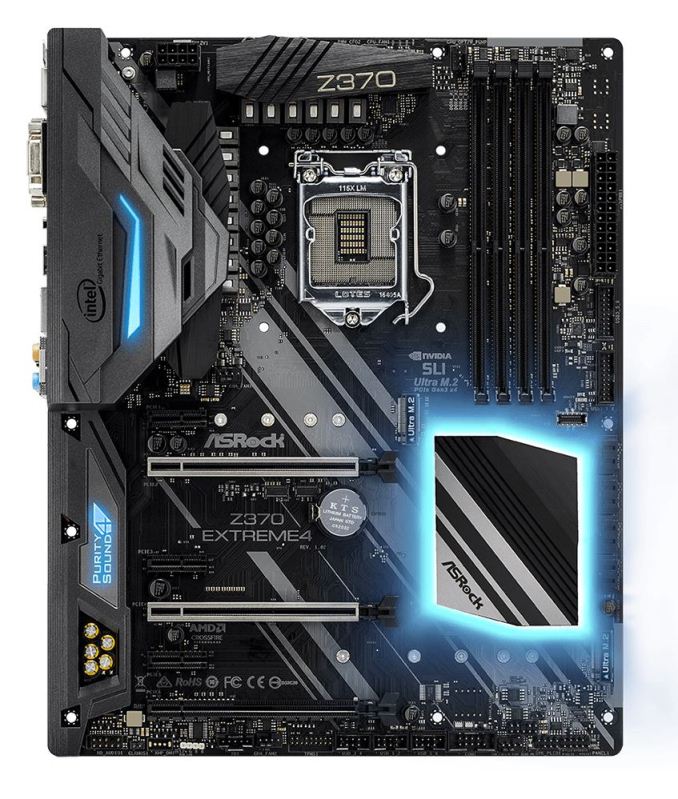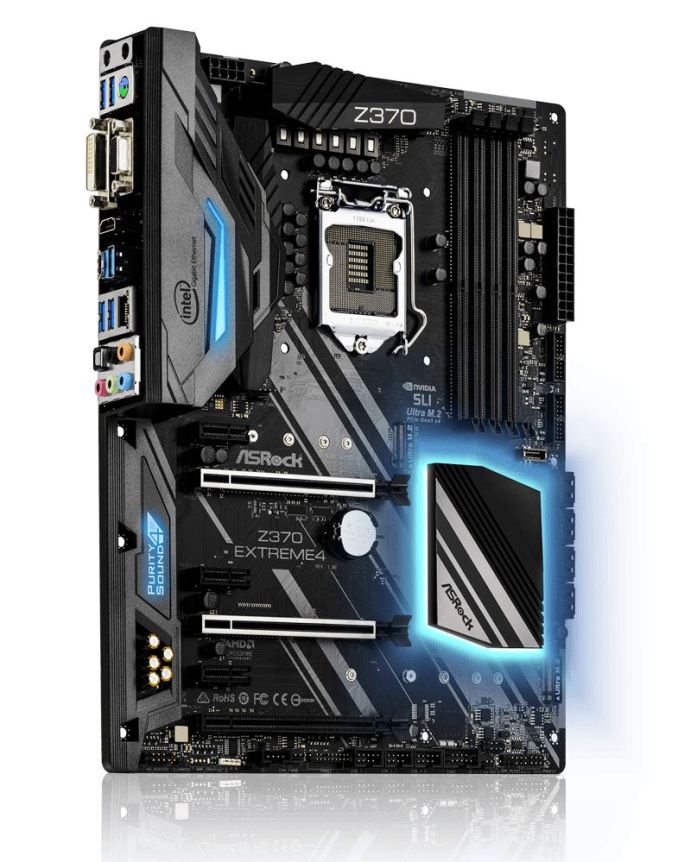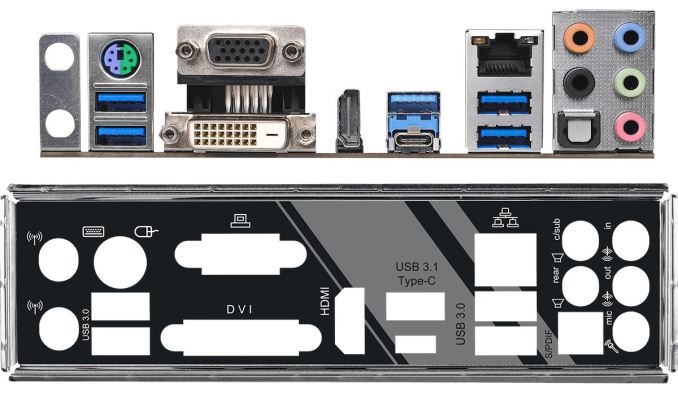Analyzing Z370 for Intel's 8th Generation Coffee Lake: A Quick Look at 50+ Motherboards
by Ian Cutress, Anton Shilov, Joe Shields & Gavin Bonshor on October 20, 2017 2:00 PM ESTASRock Z370 Extreme4
The ASRock Extreme4 is the flagship in the Extreme lineup, offering some of the same features as the Fatal1ty Gaming line. It uses the same flavor of power delivery with 60A chokes, Nichicon Combo caps, and Dual-Stack MOSFETs. What is missing on the overclocking front is the Hyper BCLK generator, so the range in which one can adjust the BCLK may not be as wide. This shouldn’t be a big issue for most considering the unlocked CPUs which will likely find their way into this socket.
The Z370 Extreme4 uses an all-black PCB with a few ‘racing’ stripes running through the board from the top left to the bottom right through the PCIe area and chipset heatsink. The Extreme4 uses the same shape and style VRM heatsinks found on the high-end boards, albeit without a heatpipe connecting them. The same style shrouding over the back panel and audio section is carried over from the flagship, and contains RGB LED features as well. The chipset heatsink is different, a bit more basic, and has RGB LEDs underneath. All the RGB LEDs, including the RGB header, can be controlled with ASRock RGB LED software.
Supported memory speeds on the Extreme4 reach up to DDR4-4333, with up to a 64 GB capacity. The top two slots are from the processor, and use reinforcement for holding heavy GPUs. The lane breakdown should be familiar with x16 cards single and x8/x8 in dual mode, while the final non-reinforced full-length PCIe slot has an additional PCIe x4 bandwidth from the chipset. There are also three x1 slots from the chipset.
Eight SATA ports are found on the board, with six using the chipset and another two using the ASM1061 (which uses a chipset PCIe x1 connection to create the two additional SATA ports). Two M.2 slots are found on the board with the top supporting up to an 80mm drive and the bottom supports 110mm drives. Lane sharing is required here when SATA drives are in play, with SATA ports 0/1 disabled when the first M.2 slot is used and the SATA 4/5 ports are disabled when the second M.2 slot is used.
Fan control is handled through the BIOS or via the F-Stream software, and it gives control to all the 4-pin headers: A CPU fan header (1A/12W), 2 chassis fan headers, and a chassis optional/water pump header (1.5A/18W). Audio duties are taken by the latest ALC1220 codec, which uses Nichicon Gold series audio caps, a Texas Instruments NE5532 headset amplifier, and the whole audio subsystem has PCB separation of the audio components from the rest of the board. Network functionality is handled by a single Intel I219-V network controller.
There are two USB 3.1 (10 Gbps) Type-A and Type-C ports on the rear panel via an ASM3142 controller, and four USB 3.1 (5 Gbps) ports fed from the chipset. Internally there are an additional three headers for USB 2.0 providing 6 ports, and two headers for USB 3.1 5Gbps support driven by the chipset or ASM1074 hub. There is also an additional new generation USB header, but this looks like it is only at 5 Gbps. The rest of the back panel consists of space for a Wi-Fi antenna in the E-key space, a combination PS/2 port, D-Sub, DVI-D, and HDMI ports for video output, and the 5 plug plus SPDIF audio stack.
| ASRock Z370 Extreme4 | |
| Warranty Period | 3 Years |
| Product Page | Link |
| Price | Amazon US |
| Size | ATX |
| CPU Interface | LGA1151 |
| Chipset | Intel Z370 Express |
| Memory Slots (DDR4) | Four DDR4 Supporting 64GB Dual Channel Support DDR4 4333+ |
| Network Connectivity | 1 x Intel I219-V GbE |
| Onboard Audio | Realtek ALC1220 |
| PCIe Slots for Graphics (from CPU) | 2 x PCIe 3.0 x16 slots @ x16 or x8/x8 |
| PCIe Slots for Other (from Chipset) | 1 x PCIe 3.0 x16 slots @ x4 3 x PCIe 3.0 x1 slots |
| Onboard SATA | 6 x Chipset 2 x ASM1061) |
| Onboard SATA Express | None |
| Onboard M.2 | 3 x PCIe 3.0 x4 - NVMe or SATA |
| Onboard U.2 | N/A |
| USB 3.1 (10 Gbps) | 1 x Type-C (ASMedia) 1 x Type-A (ASMedia) |
| USB 3.0 (5 Gbps) | 4 x Rear Panel 1 x Header 1 x ASM1074 Header |
| USB 2.0 | 3 x Headers |
| Power Connectors | 1 x 24-pin EATX 1 x 8-pin ATX 12V |
| Fan Headers | 1 x 4-pin CPU 1 x 4-pin Waterpump (1.5A/18W) 2 x 4-pin Chassis Fan 1 x Chassis Optional/Water Pump (1.5A/18W) |
| IO Panel | 2 x Wi-Fi Antenna ports 1 x PS/2 keyboard/mouse port 1 x HDMI port 1 x D-Sub port 1 x DVI-D port 1 x Optical SPDIF Out Port 1 x USB 3.1 (10 Gbps) Type-C 1 x USB 3.1 (10 Gbps) Type-A 4 x USB 3.1 (5 Gbps) Type-A ports 1 x LAN (RJ45) ports 1 x Optical S/PDIF out 5 x Audio Jacks |













83 Comments
View All Comments
tommythorn - Monday, October 23, 2017 - link
While that feature page is great, the thunderbolt part is slightly misleading as a few of them supports it via an add-in-card. The page only lists the one that has it built-in. (The lackluster support for TB3 as well as 10 GbE is disappointing).OFelix - Saturday, October 21, 2017 - link
ThanksStochastic - Friday, October 20, 2017 - link
Would you consider putting out some simple Wirecutter-style recommendations? A lot of people (including myself) would like someone else who is better informed to simplify the decision-making process.Ian Cutress - Friday, October 20, 2017 - link
When we get our Z370 reviews underway, we'll start doing some buyers guidesStochastic - Friday, October 20, 2017 - link
Great, thanks!IGTrading - Sunday, October 22, 2017 - link
When do we get a 50+ AMD motherboard article guys ? :)abrowne1993 - Friday, October 20, 2017 - link
Okay but which one looks the coolest?dave_the_nerd - Friday, October 20, 2017 - link
"Whoever thought this was a good idea at Intel needs to be fired."Well... gee... why don't you tell us how you really feel?
DigitalFreak - Friday, October 20, 2017 - link
This whole notch thing makes me wonder if the 8xxx series was originally supposed to work in existing motherboards, but Intel ran into issues at the last minute.KaarlisK - Saturday, October 21, 2017 - link
Honestly, I cannot see the issue. The pins were changed so that nothing bad will happen if you put the wrong CPU in the wrong motherboard.As for the notches, I for one am happy that they were not changed. This means they can reuse the physical design, which lowers validation costs, which makes the CPUs cheaper.